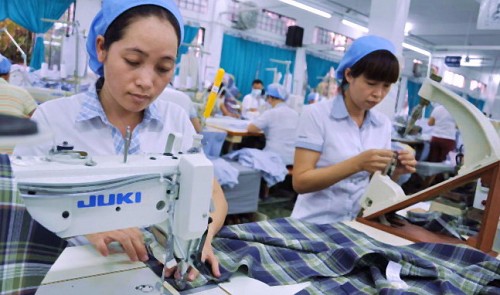Vietnam’s garment industry’s minimum wage non-compliance is the lowest among seven garment-exporting countries in Asia, a new report by International Labor Organization (ILO) has shown.
The ILO, a tripartite United Nations agency founded in 1919, works to bring together UN member states to ‘set labor standards, develop policies and devise programs promoting decent work for all women and men’.
The fifth issue of a research note on ‘Asia-Pacific Garment and Footwear Sector’ published by the organization in August addressing the problem of weak minimum wage compliance in Asia’s garment industry noted Vietnam as having the highest compliance rate of seven garment-exporting countries in Asia.
According to the report, minimum wages set the minimum amount of remuneration that an employer can legally pay a worker, the fundamental purpose of which is to protect wage earners from unduly low pay.
At 6.6 percent, Vietnam’s minimum wage non-compliance rate is the lowest among seven Asian garment-exporting countries, below the Philippines, India, Indonesia, Thailand, Pakistan, and Cambodia, in that order. This means that for every 100 wage employees in the sector, 6.6 earn less than the country’s minimum wage. This rate is far better than the next lowest country on the list, Cambodia, at 25.6 percent, and almost nine times lower than the worst offender on the chart, the Philippines, at 53.3 percent. While minimum wage compliance is weak throughout Asia’s garment industries, the depth of non-compliance varies among countries. Vietnam also stands out in this dimension, with the country’s rate of extreme non-compliance, a situation in which garment workers are paid less than four fifths of the minimum wage, at 3.8 percent.
Only a further 2.8 percent of garment workers in Vietnam are subject to moderate minimum wage non-compliance, where workers are paid from 80 to less than 100 percent of the minimum wage. By contrast, the Philippines, India, Thailand, Pakistan, and Indonesia each has approximately 25 to over 38 percent of their garment sector workers being paid far below the minimum wage.
“The depth of non-compliance is an important dimension because a worker being paid 99 per cent of the minimum is in a very different situation to one receiving only half of the minimum,” Matthew Cowgill, ILO chief technical adviser on labor standards in the global supply chain and the lead author of the report, was quoted by ILO News on Wednesday as saying. In all countries included in the ILO report, women are more likely than men to be paid below the minimum wage in the garment sector.
Vietnam is also among the nations with smallest male-female non-compliance gaps, at 5.7 percentage points, putting it behind Cambodia and Indonesia. The largest gap is found in Pakistan at 60.4 percentage points. “Although Vietnam stands out above its neighbors, any level of non-compliance with the minimum wage is a concern and this issue should continue to be closely monitored,” Cowgill was quoted as saying. “Of course, compliance with the minimum wage is not the only factor of interest. The level of minimum wages matters, too. Vietnam’s minimum wage is relatively low as a percentage of typical wages in the garment sector, when compared to other countries in the region,” the chief technical adviser continued. Vietnam has four regional minimum wages currently ranging from VND2.4 million to 3.5 million (US$108 – 157).
Each year’s minimum wages are proposed by the National Wage Council, which is made up of representatives from the Government, employers’, and workers’ organizations. While praising the compliance rate with the minimum wage in Vietnam’s growing garment, textile and footwear sector, ILO Vietnam Director Chang-Hee Lee warned that data interpretation should be done with caution.
Lee said new data is needed to see if the high compliance continued even with “significant” improvements on minimum wages in Vietnam since 2013, when the country’s data used in the research was taken.
Vietnam’s regional minimum wages increased by about 12-15 percent on a yearly basis between 2014 and 2016 and is expected to be raised 7.3 percent next year.

























































